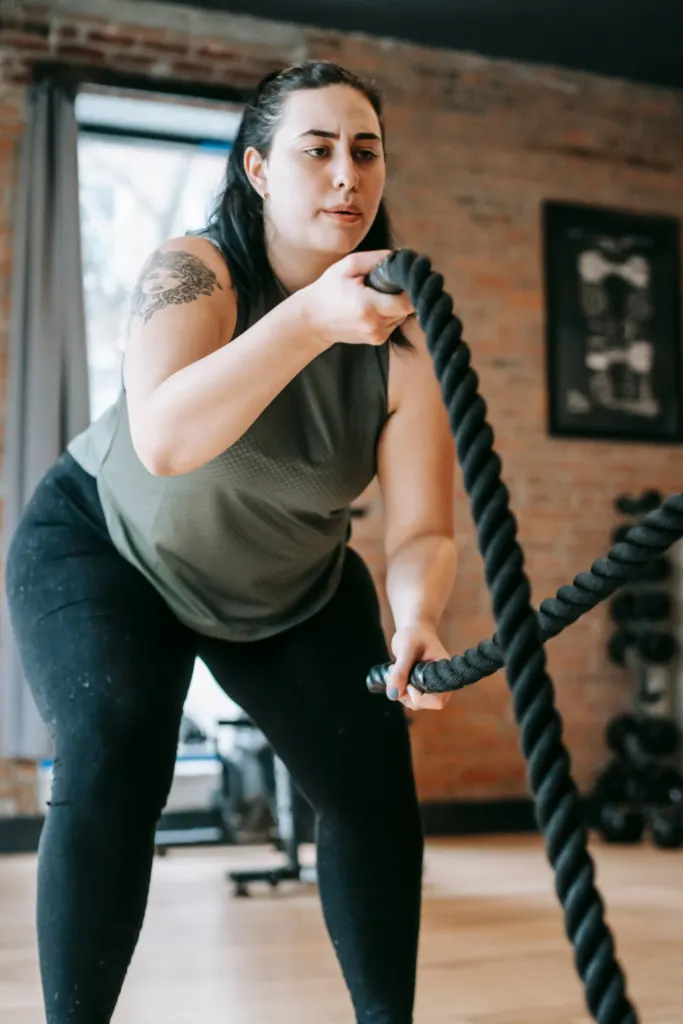Running is a great form of exercise to improve your physical and mental health, from lowering your blood pressure to boosting your self-esteem and confidence.
If you’re thinking of starting running when you’re overweight, then you may feel daunted by the road ahead.
Running when overweight can present some challenges, but with the right motivation and mindset, you’ll soon get where you want to be.
The great thing about running is that every time you take a step forward you’ll be safe in the knowledge that you’re striding towards improved health and wellbeing.
Runners come in all shapes and sizes – there is no such thing as ‘normal’ when it comes to a runner’s body.
So whether you’re returning to running following a long break, or wanting to start a new healthy habit, there are some steps that you can take to make running that much easier.
We’ll look at:
- Running when overweight: Is it safe?
- What are the risks of running when overweight?
- How to start running when overweight: 12 game-changing tips
Ready?
Let’s get going!

Running when overweight: Is it safe?
Running is generally considered safe.
However, if you have any pre-existing medical conditions, then you’ll want to get the green light from your doctor before starting running.
Book an appointment with your doctor and share your running goals.
They’ll be able to tell you if it’s absolutely safe to start.
Your doctor may recommend that you start running on a treadmill first before venturing outdoors.
This is so you can perform a ‘stress test’ to rule out any potential cardiovascular issues.
Related: 11 things I wish I’d known before running my first 10k

What are the risks of running when overweight?
As we mentioned earlier, running is generally considered safe.
However, there are a few risks of running when overweight that you should be aware of.
Of course, some of these issues are common for runners of all shapes and sizes, but they may be more problematic if you’re overweight.
Risk #1: Chafing
Chafing is a common concern for many runners.
It can be annoying, uncomfortable and sometimes painful!
Skin on skin rubbing can cause chafing, especially when you add sweat into the mix.
Clothes that rub against your skin can also cause chafing.
Risk #2: Joint pain
Running is a high impact sport and can put strain on your joints, ligaments and muscles.
Every time you take a step forward, the force of your weight is placed on your joints, particularly your ankles, knees and hips.
You can take steps to reduce joint pain by:
- Landing on your mid-foot instead of your heel.
- Keep your steps light as possible.
- Increase your cadence (the number of steps you take per minute).
- Don’t slouch forward when you run.
It’s important that you listen to your body when running and take adequate amounts of rest and recovery during and after runs.
Risk #3: Breathing difficulties
When you run your heart rate increases to allow the oxygen in your blood to be pumped around your body.
As a result, your breathing becomes more laboured as you take more oxygen in.
Try and take deep breaths and avoid shallow breathing.
If you do feel like you’re struggling to breathe, stop running and take some time to gather your breath.
Over time as you run more and more, your breathing will get easier.
Risk #4: Injury
Injuries like shin splints and runner’s knee are common amongst new runners.
Shin splints can cause pain in your lower legs and are caused by a variety of factors, including wearing the wrong shoes, running downhill and running on hard surfaces.
Runner’s knee on the other hand is characterised by pain around the knee cap area.
It’s important you recognise the signs and symptoms of these types of injuries and don’t push through the pain, as you may end up making the pain worse.
Related: Knee pain after running: Causes + 10 prevention tips

How to start running when overweight: 12 game-changing tips
#1 Wear the right running gear
First and foremost you will need to wear the right running gear on your runs.
The right running gear will benefit your running on many levels, including improving comfort and support.
Arguably the most important running gear is a pair of properly fitting running shoes.
Proper running shoes will provide the necessary comfort and stability for your feet when you run.
Running is considered a high impact sport.
So it’s important you wear running shoes to absorb shock and prevent common running injuries like shin splints.
You may also want to consider rotating your running shoes for different types of runs.
Comfortable running clothing like running leggings, a sports bra, running socks, underwear and a running top are also a must.
Opt for sweat-wicking, breathable fabrics like polyester and Merino wool.
Related: 7 of the best websites to buy affordable running clothes
#2 Start slowly
Once you’ve found the right running gear, you’ll want to jump right in!
Whether you’re excited or nervous about running when overweight, the key is to start slowly.
Carrying extra weight puts increased stress and pressure on your muscles, bones and joints, so it’s important you increase intensity slowly.
This means you will likely be walking more than running in the first few weeks to build up your endurance, stamina and strength.
Many runners think they have to run for 30 minutes or more without stopping in their first few weeks of training, when this is not realistic.
Training plans like the Couch to 5k running plan are so popular for running newbies because they offer a training program that combines walking and running intervals.
The idea is that you gradually increase the amount of running and decrease the amount of walking, until the point you can run continuously without walking breaks.
Your running pace at this stage will be slow and steady – think 60-75% on the effort scale.
You should be able to comfortably hold a conversation while you run without getting out of breath.
Related: 7 of the best running workouts to build endurance, strength and speed

#3 Remember to warm up
A warm up is important before each run to get your body and mind ready for the run ahead.
The warm up is also a great way to prevent common running injuries like shin splints and runner’s knee which are normally attributed to beginner running.
Your warm up should consist of light jogging and some dynamic stretches.
You can also include a few running drills to focus on your running technique.
Related: The 9 best pre-run stretches (and how to do them properly)
#4 Think about the end goal
Whether you want to lose weight, improve your physical fitness, boost your mental wellbeing or simply get outdoors more, think carefully about why you want to start running in the first place.
Once you know your ‘why’, you will be able to set yourself some running and fitness goals to work towards.
Goal setting is important because it allows you to track and measure your performance.
And more importantly understand what you need to change or improve to reach your goal.
Your goals need to be S.M.A.R.T:
- Specific
- Measurable
- Attainable
- Realistic
- Time Bound
For example, if you want to lose weight, instead of setting yourself the following broad goal:
I want to lose weight.
Change it up into the following SMART goal:
I want to lose 12kg by running 3 times a week over the next 6 months.
You could even make it more specific by saying setting yourself a deadline:
I want to lose 12kg by [MONTH/YEAR] by running 3 times a week.
Related: 5 important things to remember when setting effective running goals

#5 The first run will be the hardest
Starting running and your first run will always be the hardest.
Your mind will try and convince you not to go and will urge you to stay at home.
In these moments the most important actions you need to take are to lace up your trainers and head out of the door.
Once you’re out of the door and in the fresh air, it will feel a lot easier to get going.
It’s common to lose your motivation and doubt your capabilities in these first few weeks and months.
You may be thinking: “I’m not good enough” or “I can’t do this”.
Ignore your inner critic and stick with it.
You’ll soon get into a routine and with each run that goes by, you’ll be taking one more step to achieving your goals.
Related: Lost your running mojo? Try these 17 running motivation hacks
#6 Form a habit
The temptation for a lot of people is to quit at the first sign of failure.
Studies have shown that habit formation depends on the repeated performance of behaviour that is in line with your long-term goal.
In other words, being consistent is key!
Make running a part of your weekly routine.
For many people, this means creating a schedule and blocking out time in their diary so they can go running.
In the first few weeks you’ll soon find out what works for you in terms of your running routine.
Ask yourself: “Are you a morning, lunchtime, afternoon or evening runner?”
The key is to find a schedule that works for you.
Related: Make time to run: How to fit a run into a busy schedule

#7 Make yourself accountable
So you’ve found a training plan and you’ve set some time aside in your diary to go running.
But you’re struggling to find the motivation to actually go running, despite blocking out time in your diary.
This happens to all of us at one time or another!
Lack of motivation is an inevitable obstacle that you have to overcome when starting a new habit.
To keep yourself accountable, find a family member or friend to share your goals with and who can support you when times get tough.
This person will hopefully share your ambitions, intentions, plans and even fears.
Take practical steps to go running together and share your wins and setbacks.
A running buddy is one of the most powerful things to make you accountable for your runs and increase your running motivation and success rate.
Related: 51 inspiring keep pushing quotes to keep you motivated
#8 Think about your running form
Proper running form is all about running in the most efficient way possible.
As we mentioned at the start of this guide, when you’re running when overweight, you’re carrying extra weight which can cause strain and stress on your joints when running.
This is why it’s even more important to learn proper running form and technique:
- Keep your gaze upright.
- Keep your shoulders loose and relaxed.
- Don’t let your arms cross your body when you run.
- Keep your knees soft when bent when you run.
- Make sure the middle of your foot hits the ground first when you stride forward, avoid heel striking.
- Keep your cadence (number of steps you take per minute) high – imagine you’re running on ice.
Check out my guide on proper running form and technique for more information and tips.
Related: Running form and technique: 4 simple tips to improve running form on your next run
#9 Focus on food and nutrition
Eating a healthy, balanced diet is important for any athlete, but especially if you’re looking to improve your health and lose weight.
Running is one of the best exercises to burn calories, but the calories you consume still matter.
Many runners overestimate the amount of calories they burn during a run.
So they end up overeating as a result, which leads to weight gain, not loss.
The calories you consume (e.g. what foods you eat) will determine how much fat you are able to burn during a run.
Ensure your meals include the following components:
- Fruit and vegetables for vitamins and minerals
- Lean protein such as fish, chicken, beans, lentils and tofu
- Healthy fats such as olive oil, avocado, nuts
- Healthy carbohydrates such as rice, whole grain bread, whole grain pasta and porridge oats.
Of course, every individual will be different when it comes to calorie intake and balance.
However, in general, people who run regularly as part of their fitness routine should aim to get 60-70% of their calories from carbohydrates.
Lean protein and healthy fats each account for 15-20% of their remaining calories.
Related: Fat protein efficient vs. carbohydrate efficient, which is best for you?

#10 Incorporate strength training
Strength training like weight training is a great foundation for any athlete to build and maintain.
To help you run efficiently, you need to improve your muscle, joint and bone strength which can be achieved by a weekly strength training program.
Strength training exercises like bodyweight exercises are a great starting point for runners.
These are essentially exercises where you use your own bodyweight as resistance.
Exercises like squats, lunges and press-ups are great beginner-friendly exercises which can be tailored for your individual fitness level.
Exercise like yoga and Pilates are also great ways to improve your strength, balance, coordination and flexibility as a runner.
Related: The ultimate 30 day workout challenge for runners
#11 Join a running group
A running group can do wonders for your confidence, especially if you struggle to motivate yourself to go for a run.
There are many running groups and communities out there that cater for different types of runners, from beginners to elite athletes.
One such community is Too Fat To Run in the UK which is a running community for plus-sized female runners.
Too Fat To Run was created by Julie Creffield in 2010 after she finished last in a 10k race.
Says Creffield: “Not all larger runners are beginners, nor are we all on a weight loss journey. We have members in our community that are proud power walkers, and we have members that are ultra-marathon addicts, and everything in between.”
Related: 10 running clubs changing the world one step at a time
#12 Check your progress
Once you start running, it can become pretty addictive as you start to see changes in your physical and mental health.
Over time you’ll want to check your progress to see how far you’ve come and how you’re doing compared with the goals that you originally set yourself.
Progress tracking is one of the best ways to maintain momentum and motivation.
It could be in the form of distance covered, time taken to run, number of runs per week – anything really – just make sure it’s meaningful to you and your goals.
Related: 8 of the best running apps for beginners + the pros and cons of each
- 5 things I wish I’d known before returning to running - March 3, 2024
- Running 20 minutes a day: Benefits + how to start - January 27, 2024
- How to run your first 2 hour half marathon - January 16, 2024
